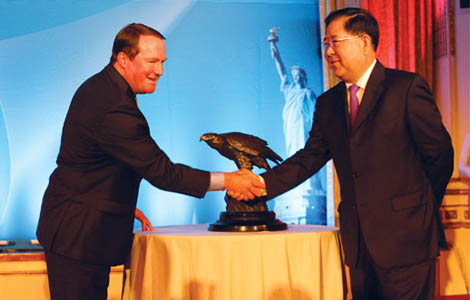Grand design
Updated: 2014-08-12 08:16
By Zhao Xu in Beijing and Zhang Chunyan in London (China Daily)
|
|||||||||
 |
|
LI MIN / CHINA DAILY |
Tan Xinyang said he made up his mind to study abroad while visiting a workshop at a design college in Australia a year ago.
"I spent my undergraduate years as an industrial design student at Tsinghua University in Beijing, arguably the best in the country not only for its science education but also for its star-studded design faculty," he said.

"In my junior year, I got the chance to go to the University of New South Wales as an exchange student. There, more than anything else, I was impressed by the level of beauty and sophistication with which the school's design students turned their ideas into reality. The models they made were simply beyond my capability. Profoundly affected and mildly humiliated, I instantly wanted to be one of them."
Tan, 23, standing outside the gate of the British embassy in Beijing last month, just after his visa had been granted, saw himself and his dream inching ever closer toward each other.
"One month from now, I'll be sitting in the classroom of the Royal College of Art in London. I got offers and scholarships from a couple of other leading design colleges in Britain and the United States, including the University of Illinois at Urbana-Champaign. But I decided on the Royal College - the only one that provides me with no financial support - because that's what I wanted the most. Money is not a problem."
The degree of freedom that Tan, whose parents happen to be rich and supportive, enjoys is bound to arouse mixed feelings from his fellow design students from humbler families. By enrolling in a prestigious overseas art/design college, he has joined a group of the well-endowed -both creatively and financially - whose members' fast-growing number sometimes belies their status as the absolute social minority in China.
"Over the past five years the number of Chinese students attending overseas art and design colleges has risen sharply," said Que Dengfeng, chairman of Juesheng.com, an education search engine and recruiting agency in Beijing for foreign universities that deals mainly with the high end of the market.
"In 2008, we helped nine students apply successfully for art and design studies with a foreign university," he said. "This included both graduate and undergraduate study."
In the first half of this year, he said, the number was 95, and he estimated that between 2008 and 2013, the total number of overseas art and design Chinese students rose 18 percent a year.
"Last year alone, 50,000 Chinese went to the United States for art and design study, and I think that figure accounted for about one-tenth of the total number of Chinese students heading for the US last year. In 2013, 9,000 Chinese traveled to Britain, to study art and design."
Commercial drive
Tan owes his entry into the Royal College of Art in no small way to Share With You, an agency in Beijing that specializes in enrolling students in MBA courses. Wang Rui, the agency's director of education counseling, said it began looking at the lucrative field of art and design 18 months ago, and Tan's is just one of several it has successfully handled.
"Most of our clients are attracted by the free-thinking spirit they believe has moored the American and European art education institutions for well over a century," Wang said.
"These young people see themselves in an innovative, iconoclastic environment in which beauty is seen as flowing rather than as fossilized and in which teachers are there to inspire instead of force students to learn."
Zuo Wen, 34, a London College of Fashion graduate who returned to Beijing to set up a couture business in 2005, decried the lack of basic training that is given to local fashion design trainees.
"It was extremely hard to find an assistant from local fashion college graduates who had intimate knowledge about the physical process of marking a piece of garment. Some graduates from the Beijing Institute of Fashion Technology handed me beautifully painted pictures of fashion. But when they were asked where the zippers should go to create the structural, ultramodern looks they had presented on paper, most had no idea," she said.
However, the superiority of foreign schools is not the sole reason for the decision of many Chinese to study abroad, said Zhao Chao, head of the industrial design department at Tsinghua University.
"Fierce competition in China is also a big factor. For example, for the past few years, Tsinghua's industrial design department has had an intake of about 20 graduate students a year, and no more than 40 undergraduate students - from well over 20,000 who take the tests. Competition is obviously cutthroat.
Most Viewed
Editor's Picks

|

|

|

|

|

|
Today's Top News
Many Chinese economic fugitives still at large in US
Chinese medical supplies arrive in Ebola-affected Sierra Leone
China's Huawei shows interest in LatAm
Kerry: Formation of Iraqi govt critical for stability
Shooting leaves 2 dead, 5 injured in New Orleans
Police focus on emigrants who still have their hukou
Chinese Ebola doctors leave for Africa
At least 39 killed in Tehran jet crash
US Weekly

|

|
















